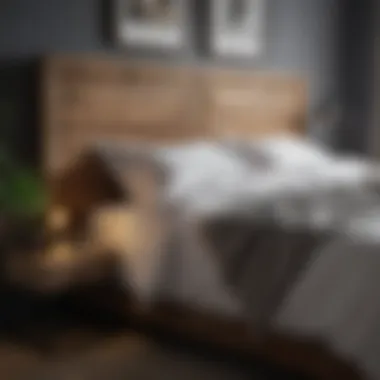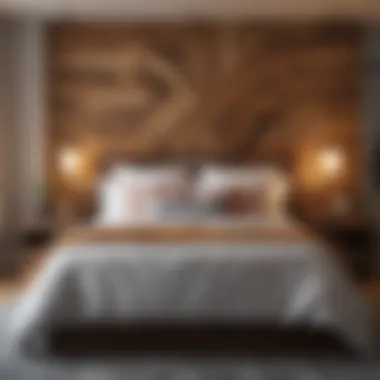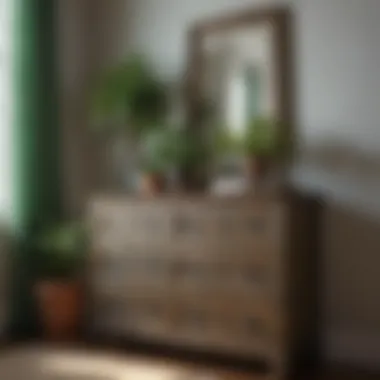Enhancing Bedroom Aesthetics with Sustainable Reclaimed Wood


Materials:
To kickstart your journey into integrating the elegance of reclaimed wood into your bedroom, you will require a specific set of materials. Make sure you have the following items ready:
- Reclaimed wood planks (measurements: varying based on your design preferences)
- Nails and a hammer
- Sandpaper (grit range: 80-120)
- Wood finish (choose a eco-friendly option for sustainability)
- Measuring tape
- Safety goggles and gloves (prioritize safety during the project)
DIY Steps:
Now that you have gathered all the necessary materials, let's delve into the step-by-step process to infuse your bedroom with the beauty of reclaimed wood. Follow these detailed instructions meticulously:
- Measure the wall space where you plan to install the reclaimed wood planks. Accuracy is key to ensure a seamless installation.
- Sand the surface of the reclaimed wood planks thoroughly to remove any rough edges or imperfections, achieving a smooth finish.
- Decide on the pattern you wish to create with the wood planks – whether it's a uniform arrangement or a more artistic design.
- Secure the wood planks to the wall using nails and a hammer, applying even pressure to ensure stability.
- Once all planks are installed, apply the wood finish evenly to protect the wood and enhance its natural beauty.
Technical Aspects:
In addition to the materials and DIY steps, paying attention to technical aspects is crucial for a successful reclaimed wood project. Here are some key technical details to consider:
- Tools: Ensure you have the precision tools necessary for the job, such as a measuring tape and sandpaper with the recommended grit range.
- Timing: Dedicate ample time for each step, especially when sanding the wood and applying the wood finish to achieve a professional result.
- Techniques: Embrace techniques like staggering the wood planks for a visually appealing outcome, adding depth to your design.
DIY Project Process:
As you progress through the DIY project, following a sequential approach is essential to project cohesiveness. Let's outline the installation method in detail, highlighting key techniques and timings:
- Begin by starting at one corner of the wall and gradually work your way across to ensure a uniform installation pattern.
- Use a level to guarantee straight and aligned placement of each wood plank, creating a polished final look.
- Check periodically for any gaps or inconsistencies in the installation, adjusting as needed for a seamless result.
Troubleshooting Tips:


Despite meticulous planning, DIY projects can encounter challenges. Here are some common troubleshooting tips to keep in mind:
- If the wood planks do not fit perfectly, gently sand the edges for a better fit while maintaining the overall aesthetic.
- In case of visible nail heads, use a wood filler to cover them up and maintain the smooth appearance of the reclaimed wood surface.
- For uneven wood finishes, consider applying an additional coat or experimenting with different application techniques for a refined look.
Foreword
Reclaimed wood holds a captivating allure, blending rustic charm with an environmentally conscious ethos. As we delve into the nuances of incorporating reclaimed wood into bedroom design, we embark on a journey that transcends mere aesthetics. This article serves as a beacon of inspiration, shedding light on the symbiotic relationship between sustainability and elegance within interior spaces. Let us navigate through the intricate details of utilizing reclaimed wood to infuse warmth and character into the sanctuary of the bedroom.
Understanding Reclaimed Wood
Definition of Reclaimed Wood
Reclaimed wood epitomizes a fusion of history and artistry, embodying a narrative rich in heritage and sustainability. Its essence lies in salvaging timber from old barns, factories, and other structures, giving it a new lease on life. The key characteristic of reclaimed wood lies in its aged patina and the stories it carries within its grain. This feature not only adds a touch of nostalgia but also contributes to reducing the demand for fresh timber, making it a favorable choice for conscientious design enthusiasts. While its unique imperfections may pose challenges in uniformity, they also bestow a distinct charm that sets reclaimed wood apart in the realm of interior decor.
Sources of Reclaimed Wood
The provenance of reclaimed wood spans diverse origins, ranging from historic buildings to robust shipping pallets. Each source contributes a distinct aesthetic character, from the weathered planks of a dismantled barn to the smooth surfaces of repurposed industrial beams. The allure of reclaimed wood lies not just in its visual appeal but also in the environmental benefits it offers. By repurposing existing wood, we mitigate the depletion of forests and reduce carbon emissions associated with timber production. However, ensuring the authenticity and quality of reclaimed wood remains paramount, as not all sources uphold sustainability standards with equal fervor.
Benefits of Reclaimed Wood
Sustainability
At the core of reclaimed wood lies its unparalleled sustainability, epitomizing conscious consumption and responsible stewardship of natural resources. By repurposing timber that would otherwise languish in landfills or be subjected to incineration, we minimize our ecological footprint while attaining a sense of environmental harmony. The longevity of reclaimed wood further bolsters its green credentials, offering a durable alternative to fleeting fast furniture.
Unique Aesthetic Appeal
The charm of reclaimed wood lies in its inherent imperfections, which narrate a story of bygone eras and venerable craftsmanship. Its visual allure transcends trends, fostering a timeless elegance that resonates with both traditional and contemporary design sensibilities. The interplay of textures, tones, and grain patterns within reclaimed wood infuses spaces with a sense of character and soul, elevating the ambiance to evoke a cozy yet sophisticated atmosphere.


Durability
Contrary to misconceptions surrounding aged materials, reclaimed wood boasts exceptional durability due to its seasoned nature. With proper maintenance and care, reclaimed wood furniture can withstand the rigors of daily life, acquiring a rich patina that accentuates its beauty over time. The robust resilience of reclaimed wood instills confidence in its longevity, ensuring that investments in sustainable design endure for generations to come.
Incorporating Reclaimed Wood in the Bedroom
Reclaimed wood holds a distinct allure when incorporated into bedroom decor, combining rustic charm with a sustainable ethos. In this article, we delve into the significance of utilizing reclaimed wood in bedroom interiors, emphasizing its unique elements that contribute to a cozy and environmentally friendly ambiance. By choosing reclaimed wood for your bedroom, you not only add a touch of history and character but also align your decor choices with sustainable living practices.
Reclaimed Wood Bed Frame
For the \
DIY Projects with Reclaimed Wood
Reclaimed wood DIY projects offer a unique opportunity to infuse personalized and eco-friendly elements into your bedroom decor. By engaging in hands-on creative endeavors, one not only adds a bespoke touch to their living space but also contributes to sustainability efforts. These projects resonate with individuals aiming for a distinct aesthetic appeal while reducing their ecological footprint. Whether it's a headboard, floating shelves, or other furniture pieces, reclaimed wood DIY projects allow for a harmonious blend of functionality and style, aligning with the overarching theme of the bedroom's design philosophy.
Headboard
Step-by-Step Guide
The step-by-step guide for creating a reclaimed wood headboard provides a structured approach to crafting a centerpiece for the bedroom. This meticulous process ensures precision, from selecting the right wood pieces to assembling them seamlessly. The guide emphasizes the importance of measurements, cutting techniques, and finishing touches for a polished final product. It serves as a fundamental resource for both novice and experienced DIY enthusiasts looking to embark on a rewarding woodworking project unique to their personal style preferences.
Personalization Options
Personalization options for reclaimed wood headboards allow individuals to tailor their bedroom furnishings to match their taste and preferences. Choosing from a variety of finishes, patterns, and sizes enables homeowners to create a focal point that complements the existing decor seamlessly. By incorporating personal touches such as carved designs, paint accents, or intricate detailing, one can express their creativity while showcasing the natural beauty of reclaimed wood. These customization choices add character and individuality to the headboard, elevating the visual appeal of the entire bedroom space.
Floating Shelves


Installation Tips
The installation tips for reclaimed wood floating shelves focus on ensuring secure and stylish placement within the bedroom. Emphasizing sturdy mounting techniques, weight distribution considerations, and alignment precision, these tips guarantee both practical functionality and aesthetic charm. By following the recommended installation steps, individuals can showcase their decorative items, books, or plants with confidence, adding a touch of rustic elegance to the room while optimizing storage solutions.
Decorative Potential
The decorative potential of reclaimed wood floating shelves lies in their versatile and visually appealing design. These shelves not only serve as storage units but also double as decorative accents, enhancing the overall aesthetic of the bedroom. Their ability to seamlessly blend with various interior styles, from minimalist to eclectic, makes them a popular choice for design enthusiasts seeking both functionality and beauty. With different lengths, depths, and finishing options available, these shelves offer limitless decorative possibilities, allowing homeowners to curate a space that reflects their unique personality and design sensibilities.
Maintaining Reclaimed Wood Furniture
In the realm of furniture design, the aspect of maintenance often occupies a pivotal role, especially when dealing with the intricate elegance of reclaimed wood. Understanding the idiosyncrasies inherent in reclaimed wood furniture becomes imperative to uphold its timeless allure and durability. This section will delve into the significance of maintaining reclaimed wood furniture within the context of sustainable interior design.
Cleaning Techniques
Regular Care
Regular care of reclaimed wood furniture entails a meticulous approach to ensure its longevity and visual appeal. Embracing routine dusting and polishing routines not only enhances the wood's natural beauty but also protects it from environmental factors. The key characteristic of regular care lies in its ability to preserve the authenticity of reclaimed wood, unveiling its unique grains and textures with a gentle touch. Opting for regular care is a prudent choice for individuals seeking to maintain the organic charm of reclaimed wood furniture, fostering a connection with nature in their living spaces.
Avoiding Water Damage
A paramount concern when caring for reclaimed wood furniture is protecting it from water damage. Water can seep into the wood, causing warping, discoloration, and ultimately compromising its structural integrity. Vigilance in preventing water exposure through coasters, placemats, and immediate cleanup of spills is crucial. The distinctive feature of avoiding water damage lies in its proactive approach to safeguarding the natural essence of reclaimed wood, shielding it from harm while retaining its innate beauty. Implementing strategies to avoid water damage is indispensable in maintaining the longevity and aesthetics of reclaimed wood furniture in your home.
Refinishing Reclaimed Wood
Refinishing reclaimed wood is an art form that revitalizes its aesthetic appeal and extends its lifespan. This process involves imbuing the wood with fresh finishes to restore its sheen and character, breathing new life into weathered surfaces.
Tips for Restoring Shine
Elevating the shine of reclaimed wood necessitates careful selection of finishes and application techniques. Utilizing natural oils or waxes can accentuate the wood's natural luster while providing a protective coating. The key characteristic of tips for restoring shine lies in their ability to revitalize the wood's appearance without compromising its rustic charm. By implementing these tips, individuals can infuse renewed radiance into their reclaimed wood furniture, elevating the ambiance of their living spaces.
Preserving the Weathered Look
Preserving the weathered look of reclaimed wood celebrates its journey and history, reflecting the passage of time through its patina and imperfections. This approach involves safeguarding the wood's existing texture and color, embracing its authenticity. The unique feature of preserving the weathered look lies in its ability to encapsulate the story of the wood, honoring its past life while integrating it into contemporary settings. Balancing preservation with maintenance ensures that the weathered look of reclaimed wood remains a captivating focal point in interior design, evoking warmth and character.







